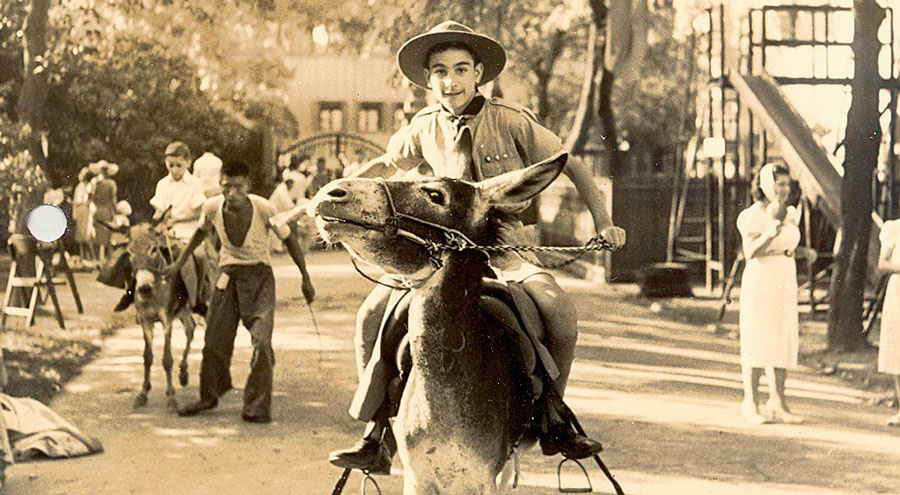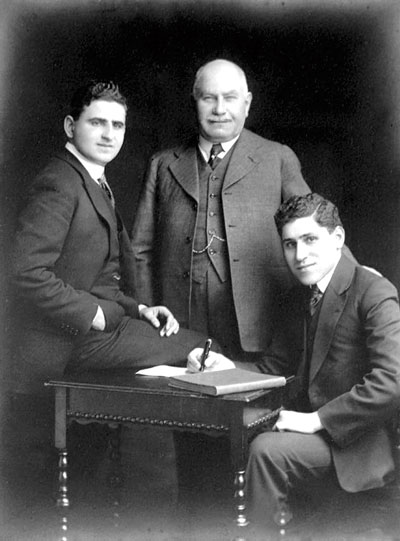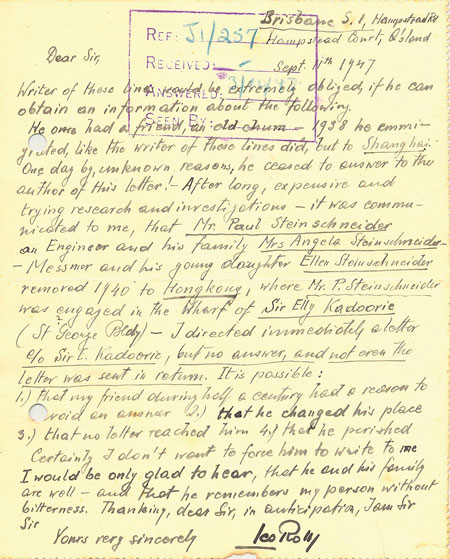Op Eds & Articles

Courtesy of

![]()
The Kadoorie Family
The Kadoorie Family, Sephardi Jews, emigrated from Baghdad in 1880 to settle in the Far East. The family fortunes were founded by Sir Elly Kadoorie and Sir Ellis Kadoorie, who were pivotal players in the development of business giants such as the Hongkong & Shanghai Hotel Co. and China Light and Power. Elly’s sons, Lord Lawrence Kadoorie and Sir Horace Kadoorie continued the family businesses and philanthropic pursuits. The family is today headed by Lawrence’s son, Sir Michael Kadoorie.
The Hong Kong Heritage Project

In May 2007, Sir Michael founded the Hong Kong Heritage Project (HKHP). The HKHP is the first of its kind in Hong Kong; a project supported and driven by business with the purpose of preserving community history. The HKHP does this by promoting new avenues of research, enriching Hong Kong’s existing archival collection, encouraging young people to participate in the preservation of their community history and capturing unrepresented voices in Hong Kong’s historical narrative through the collection of oral history. The HKHP is housed in an archive facility in Kowloon which holds 3,100 Kadoorie related records, as well as 550 filmed oral history interviews. The Archive was officially opened to the public in March 2009, and since then, has welcomed visitors from Shanghai, Israel, the United Kingdom, the United States, Australia and within Hong Kong’s academic community.
The Jewish Collection
Arguably the most precious and unique collection in the HKHP Archive are the records relating to the Jewish communities of Hong Kong and Shanghai, whose own records were mostly lost or destroyed during the Japanese Occupation in the Second World War. The Kadoorie Family’s status and position within these two Jewish communities meant that high-level records were created and preserved by the Kadoorie brothers, Lawrence and Horace, in St. George’s Building, the Family’s Hong Kong office. Most records miraculously survived the Japanese Occupation in good condition (exempting the period 1942 – 1945). Recently rediscovered, this collection has been described by some within the Jewish Community today as “our lost records”. Indeed, using these records, it has been possible to trace a coherent historical thread from which we can expose the previously hidden dimensions of the Jewish community in the Far East during the inter-war years and beyond. The Jewish Collection spans eighty years, from 1902 to 1982. The records are mainly in the form of correspondence, written between the Kadoorie brothers or with other leading members of the Jewish Community. Records also include Ohel Leah Synagogue membership lists and statement of accounts, photos, pamphlets, and oral history interviews. Notably, the number of oral histories in the Jewish Collection reached over 100 in 2010, after the receipt of interviews undertaken by the Holocaust Center of Northern California in the 1980s – 1990s.

The Ohel Leah Synagogue Records 1902
The oldest surviving record in the Jewish Collection is a small booklet containing the 1902 Rules and Regulations of the Ohel Leah Synagogue. Generously donated by Sir Jacob Sassoon and named after his mother Leah, the Synagogue was built in 1902, on land given to the Jewish community by Sir Jacob and his brothers Edward and Meyer. Rule 3 of the 109 year old booklet displays its age: “Every subscriber shall pay a sum of not less than two dollars per month to be collected quarterly in advance.” The financial accounts of the Synagogue in the inter-war years (including 1941) have also been preserved. These are of particular interest in that they give the names, extent, and organizational structure of the members of the community during that era. Notable families during this time included the Gubbays, Abrahams, Raymonds and the Josephs. In 1936, there were only 38 individual subscribers to the Ohel Leah Synagogue, which comprised 25 families.
Outbreak of War and Hong Kong
The records also give clues as to the charitable work and impact of the Second World War on the established Jewish communities in Hong Kong and Shanghai, and the plight of the European Jewish refugees escaping Nazi tyranny to Shanghai in the late 1930s. Lawrence Kadoorie’s 1939 speech at the Hong Kong Jewish Recreation Club (J.R.C), in his capacity as President of the Ohel Leah Synagogue, describes the desperate plight of Jewish communities abroad and the role played by the Hong Kong community in supporting the refugee Diaspora. The formation of the Jewish Refugee Society, the long-standing work undertaken by the Jewish Benevolent Society and the frequent visits to the Passport Office “on the subject of refugees who were in transit or have settled in the Colony” showed the Hong Kong community to be active, organized and aware. In his speech, Lawrence reiterated that each and every member had their own crucial role to play: “Today more than ever it is the duty of every Jew to realize his responsibilities.” Another area in which the Hong Kong Jewish Community was active was in the creation of an Entertainment Committee for the “soldiers of the Jewish persuasion” posted to Hong Kong during the Second World War. The Committee came about in July 1941, when Lawrence Kadoorie asked Mrs. Odell, an active member of the Jewish Community to help carry out a program for the entertainment of these men. The hope was to “make these men feel at home, more especially as most of them are away from England for the first time and are feeling the separation from their relatives and friends.” Events organized in 1941 included a dinner service on 1 October for Yom Kippur and an “At Home” held at the J.R.C. on 9 August.
Shanghai Refugees 1938 – 1945
Meanwhile, in the visa-free port of Shanghai, the numbers of European Jewish refugees arriving escalated to 15,000 in the 10 months from December 1938 through to September 1939. Various organizations were hastily established in Shanghai and elsewhere to support this burgeoning and penniless refugee population. The HKHP Archive holds pamphlets, letters and minute meetings of these organizations such as the Hilsfond Fuer Deutsche Juden, the American Jewish Joint Distribution Committee (JOINT or the JDC as they are better known today) and the Committee for the Assistance of European Jewish Refugees in Shanghai, which issued passports, kept registries, provided assistance in finding jobs as well as financial aid and accommodation for the refugees.

S.J.Y.A: The Beginning
Horace Kadoorie established the Shanghai Jewish Youth Association (S.J.Y.A) in February 1937 – before many of the Jewish refugees had arrived – after a visit to the Shanghai Jewish School (S.J.S) in early January 1937. There, he found the children malnourished, plagued by tuberculosis and with little to no opportunities for employment. Soon after establishing the S.J.Y.A, an educational program was in full force, including business classes and an “Employment Bureau” at the Nieh Chih Kuei School, which was loaned to the Association by the Shanghai Municipal Council until 1941, when they were compelled to leave. The S.J.Y.A also hosted summer camps with the tag-line: “The Jewish Children’s Fresh Air Camp”. Activities at the 1938 camp held on the grounds of the Shanghai University included a Fun Fair, evening film screenings, athletic events and amateur theater productions. By February 1939, with the huge influx of refugees (arriving at this time at over 1000 per month) and the current S.J.S unable to cope with the increase in numbers, the S.J.Y.A expanded its activities from summer clubs and camps to regular education, and focused its attention on refugee children, after which the S.J.Y.A School, otherwise known as the Kadoorie School, became the largest Jewish School in Shanghai and an indispensable support network for refugee families.
Post-War Years
The records between the years 1942 – 1945 are lost to history as a consequence of the Japanese Occupation, but they pick up in earnest in 1945 to tell the story of the influx of refugees coming out of Shanghai and into Hong Kong, the end of the S.J.Y.A and the re-establishment of the Jewish Recreation Club in 1950. Work with the JDC 1940s – 1950s After the end of the War, hundreds of Jewish refugees passed through Hong Kong on their way out of China, prior to and after the founding of the People’s Republic of China. Lawrence and Horace Kadoorie paid weekly visits to the Hong Kong Immigration Department in the 1940s and 1950s to ensure the refugees would have the necessary visas ready for resettlement to Israel and elsewhere. Preserved in the Archive are the thousands of letters written to governments, embassies, shipping lines and individuals to guarantee successful repatriation. Many were accommodated in The Peninsula Hotel, where Lawrence had been Chairman before the War, due to the acute accommodation crisis. Also forming part of this JDC collection are letters forwarded by Horace, at that time the Hong Kong representative of the JDC, to and from refugees still residing in China. This free postal service, instituted at a time when formal postal channels were still closed, was a vital means of communication for the refugees who were finally able to make their first contact with friends and family abroad.
SJYA: The Final Days

In 1945, Horace was optimistic about the future of the S.J.Y.A School. He continued to be actively engaged in its affairs, and undertook fundraising just months after the end of the War. In November, he invited 22 leading members of the Ashkenazi Community for tea to Marble Hall (at that time the Kadoorie’s residence in Shanghai) in the hope of raising funds and support for the school. A year later, the school was running smoothly. Horace’s letter to a friend in 1946 was reassuring: “I know that you will be glad to hear that S.J.Y.A affairs are progressing nicely. The JOINT are helping out and Mr. and Mrs. Grodsky take great interest in the centre. Mr. Toochinsky has been appointed Treasurer and is making a drive for funds amongst the Russian Community; Mr. Hamowy has promised to make a drive amongst the Syrian Community.” In 1947, despite the school’s remarkable 99% pass rate in the Cambridge Senior Examination, the future looked bleak. Funds were drying up and the community’s numbers were rapidly dwindling as families continued to leave Shanghai. The school was dealt a further blow the following year when the much loved headmistress, Lucie Hartwich, immigrated to Australia due to “the difficult local situation”. By 1949, only 40 students were enrolled in classes. Although the “Kadoorie School” was kept open for as long as possible, in early 1949, as the Red Army approached Shanghai, the school was soon to come to an end.
Jewish Recreation Club 1950 – 1984
After his return to Hong Kong from Shanghai in 1949, Horace became the first President of the newly built Jewish Recreation Club (J.R.C). The J.R.C was established as an Association in 1905 and expanded by Elly Kadoorie in 1909. The beautiful J.R.C building survived the Japanese Occupation until two weeks prior to the termination of hostilities, when the Japanese forces pulled the Club down. The Club was rebuilt five years after the cessation of the War by the Hong Kong Jewish Community. Records in the Jewish Collection chronicle the re-opening of the Club in 1950, and give an insight into the running of the Club, the nature of the Jewish Community in the immediate post-War years and the activities and organizational structure of that community. Less successful, however, were the Flannel Dance and Film Show held in the same year. The Flannel Dance was “a pronounced flop due to the lack of the fairer sex” and despite the advantages of expert advice, the Film Show was a damp squib due to the worn out film soundtrack and acoustic difficulties. Other activities arranged by the J.R.C included Tombola Sessions, fund-raising drives for Israel, events hosted by the Jewish Women’s Association and a Hanukah Ball. Most of the Club’s expenses in the opening year went towards the building and grounds, with purchases such as electric fans, a floor polisher and a hard tennis court. At the end of the first year, Horace gave a positive appraisal of the J.R.C in his President’s speech: “I am glad to say that the Club has, and is, fulfilling its intended purpose, namely, to act as a meeting place for the Jewish Community…. It provides cultural and social amenities for its members.”
Giving the lost records a new life
An exhibition showcasing selections from HKHP’s Jewish Collection was held in October 2010 at the Hong Kong Jewish Community Centre in conjunction with the Hong Kong Jewish Historical Society. Arrangements are underway to have the exhibition, entitled The Jews in Shanghai and Hong Kong: The Lost Records 1938-1950, displayed at universities and other institutions as well. The HKHP will continue to preserve and share what is more than the story of the Kadoorie family and more than the story of the Jewish community but is rather a piece of the history of Hong Kong as a whole.

For more information on HKHP’s Jewish or wider collection, or to visit the HKHP, contact : enquiry@hongkongheritage.org

 Back
Back